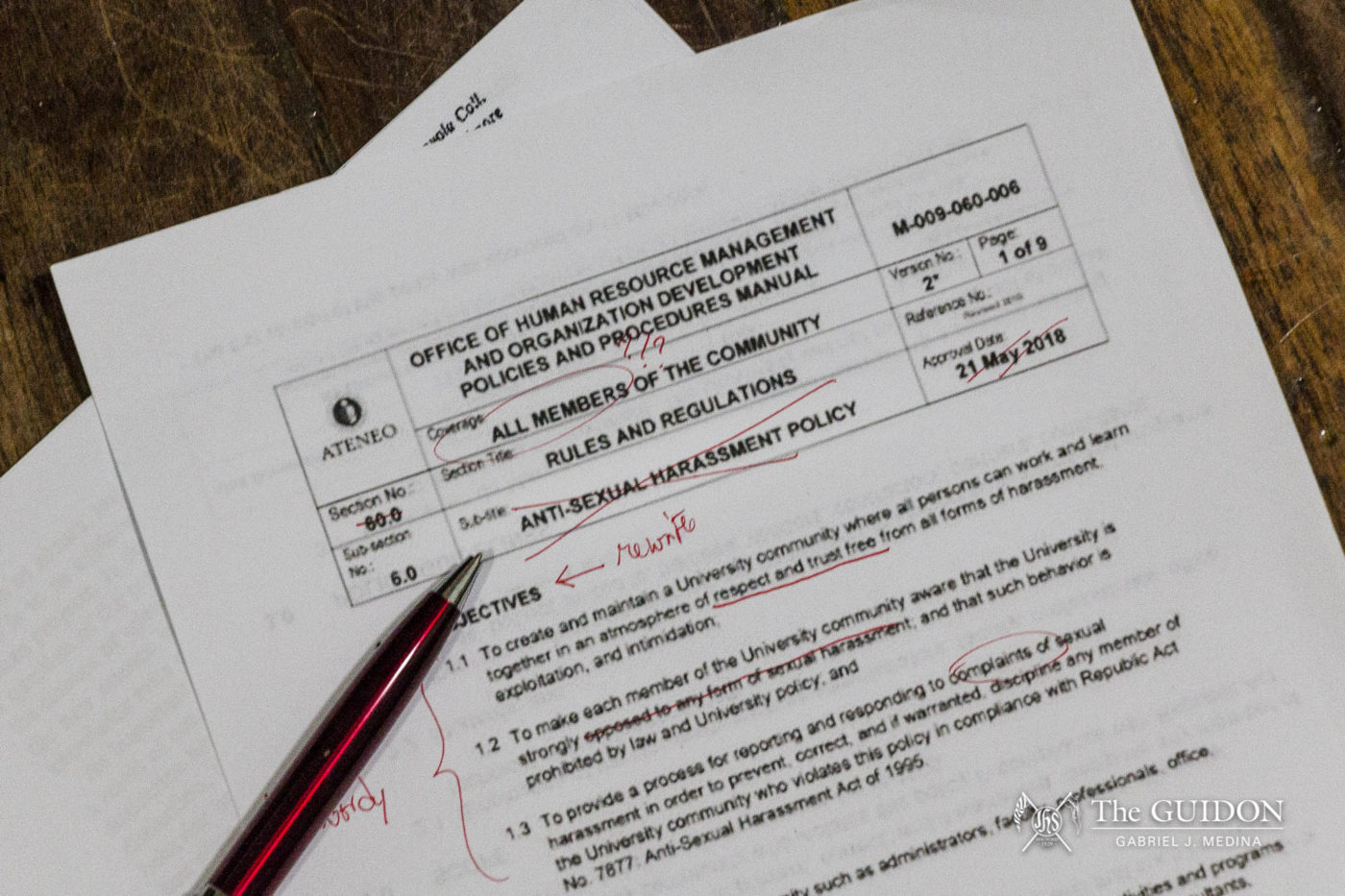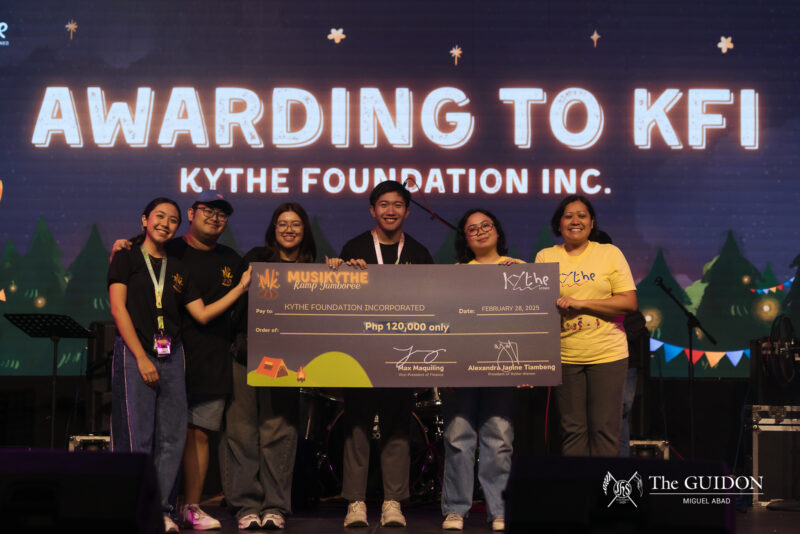AN ANTI-SEXUAL Harassment Manual is now being drafted by Legal Counsel for the Loyola Schools (LS) Attorney Nina Sison-Arroyo. University President Jett Villarin, SJ, announced its creation one day after the mobilization against sexual misconduct and impunity took place in front of the Horacio Dela Costa Hall on October 15.
According to Sison-Arroyo, the manual will replace existing policies regarding sexual misconduct on campus in hopes of establishing clearer guidelines to address these cases more efficiently. It is targeted to be completed by the end of the year.
In line with this, a recent update published by University Gender Focal Point stated that the process of gathering input for the manual from different stakeholders from the Ateneo grade school, high school, and professional schools has since commenced.
Since the public was informed about the creation of the manual, people have wondered if the move only served as an act to appease public clamor. However, Sison-Arroyo assured that what prompted the creation of the manual was in adherence to Article 5 of the Safe Spaces Act, which officially took effect last August 3, 2019, as it mandates academic institutions to publish grievance procedures in order to “facilitate the filing of complaints by students and employees.”
Although the manual is expected to be completed by the end of the year, Sison-Arroyo emphasized that, as of writing, their office still cannot disclose the document’s concrete and specific details because it is still in its early stage of conceptualization.
Setting clearer policies
With policies regarding sexual harassment currently in place, Committee on Decorum and Investigation Chairperson Norberto Bautista, SJ, explained that the manual aims to cover the various sexual harassment policies for the different units in the Ateneo—from grade school to the professional schools—by expanding the current protocol for sexual misconduct on campus. The revisions will supposedly focus on updating the “definition of sexual harassment, imposable sanctions, grievance procedures, and modes of intervention and assistance.”
“The contents [of the manual will] be more particular [to] the specific contexts and circumstances of each unit in the [Ateneo]. I was thinking more concrete, more detail. [It] includes [protocol regarding the] decorum of all the members of the community: The faculty, students, etc.,” Bautista said.
Sison-Arroyo explained how the current policies “are very basic in the sense that [they are] almost just a mirror image of the Anti-Sexual Harassment Law of 1995.” Thus rendering limited and unclear procedures in addressing cases of sexual harassment on campus, especially in the modern, highly digital context.
In line with this, the manual will provide an expanded definition of sexual harassment to encompass specific forms of behavior that were not previously recognized as such in the Anti-Sexual Harassment Law, but are now identified in the Safe Spaces Act. These include acts like groping, spreading nude photos, and making sexist remarks. The law has also expanded to include peers as possible offenders, even if they were not considered as such under the Anti-Sexual Harassment Law.
“What we need to do is to contextualize [the current policies] better in our setting as a University. We have to translate that language into a language that we [can] understand,” she said.
Closing the communication gap
Sison-Arroyo said that the manual will address the current communication gap between the different offices on campus when processing the cases of sexual harassment. According to her, many are still unaware of the protocols in place, making it necessary for the manual to lay out clear guidelines on exactly how cases are processed.
Sison-Arroyo added that doing so would help the community understand how all the offices and administrators in the University work together in addressing cases of sexual harassment on campus: “Right now, there are pockets of effort, but it’s not really synergized in the way that we are all acting together towards the same direction. Having [the protocol] in writing in one document will help paint the entire picture.”
Sison-Arroyo described her role in the process of creating the manual as one of a “chronicler,” as she gathers information through various means, including focus group discussions and research on existing sexual harassment policies of other universities, among other efforts.
LS Gender Hub Director Mira Ofreneo, PhD also discussed how the creation of the manual will offer much needed clarity in understanding the procedures in filing a sexual misconduct complaint. She noted that knowing the process will allow individuals to be more comfortable with coming forward with their grievances.
“What [we want] to arrive at is clarity in the procedure [of processing sexual harassment cases on campus]. And by clarity, I think it’s really identifying each step in the process, what happens there,” she explained.
Other avenues
Among the University’s other efforts to address cases of sexual harassment is the creation of the LS Gender Hub last academic year. Villarin described the LS Gender Hub to be comprised of a committed set of individuals who are willing to assist members of the LS community, especially survivors, in dealing with sexual harassment cases.
“The point is, the Gender Hub was created to address a gap that has been identified previously, which is to have [a] place or a space which will cater to the needs of those who need to file a complaint,” Ofreneo shared.
To ensure that the LS community is heard while policies undergo revisions, the Commission on Anti-Sexual Misconduct and Violence (CASMV) assured that the LS community is represented through the commission’s presence in meetings with the administration. Under the Sanggunian, CASMV aims to assist student survivors who need further guidance on filing sexual harassment cases. During these meetings, CASMV Comissioner Arianna Sunga said that the feedback received from complainants and other members of the community are raised.
“A CASMV Commissioner has been present in all of the meetings and negotiations with the administration thus far and will continue to be involved in future discussions, providing [CASMV’s] insights on how the handling of sexual harassment cases can be improved,” Sunga explained.
In line with this, Sison-Arroyo stated that feedback from the community is a valuable asset in the creation of the manual. She said that the implementation of the Safe Spaces Act and the re-emergence of discourse pertaining to sexual harassment on campus converged in a timely manner.
“Now is the best time to listen to everyone’s views because there are a lot of views coming out on how the system can be improved, and all that can be taken into consideration as we recraft our policy,” she stated.
What do you think about this story? Send your comments and suggestions here: tgdn.co/2ZqqodZ







